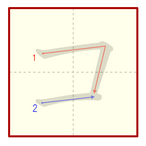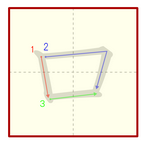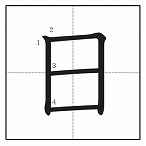Lesson 7 : Level 3 : Katakanas with ORERU at a right angle & "box-like" Kanjis
×
[PR]上記の広告は3ヶ月以上新規記事投稿のないブログに表示されています。新しい記事を書く事で広告が消えます。
コメント
ただいまコメントを受けつけておりません。
Lesson 7 : Level 3 : Katakanas with ORERU at a right angle & "box-like" Kanjis
Now, we are going to study letters with ORERU line again. But in this lesson, the ORERU line changes it's direction at a almost right angle.
コ【ko】

Want to check the stroke order with the movie? Click here
It has one of the basic stroke, Left to Right and Top to Bottom.
It looks like add a line to it's hiragana.
Because the original Kanji is the same one, it is natural that Hiragana こ and Katakana look alike.



ユ【yu】

Want to check the stroke order with the movie? Click here
Now the first stroke of コ is smaller with this letter. Then the end of the first stroke touches at the middle of 2nd stroke, the horizontal line.
ヨ【yo】

Want to check the stroke order with the movie? Click here
Just add a horizontal line to コ. But don't write コ first and add a line at the middle. Follow the stroke order. A horizontal line at the bottom should be at the last stroke order. This is one of the basic rules of Japanese writing.
ロ【ro】

Want to check the stroke order with the movie? Click here
This is just "a square" for you guys, bigginers of Nihongo. Anyway, it is important to follow the stroke order. Remember that the horizontal line at the bottom should be the last stroke order.
Now you can add a Kanji to our "done" list
口【kuchi / くち】=mouth

Want to check the stroke order with the movie? Click here
See? It's exactly the same as Katakana's ロ.
The Kanji's origine is the shape of our mouth
.

Then there are 3 easy Kanjis which is applying the tequniques to write ロ. All of them are looks "box-like" for foreigners.
日【hi / nichi】

Want to check the stroke order with the movie? Click here
Important stroke-rule is "the bottom horizontal line should be the last stroke".
Don't close the box before putting inside of it. :)
The letter represents "day". So the origin is the simble of the day, the Sun.

With additional one line... it's becoming..
目【me】= eye

Want to check the stroke order with the movie? Click here
The origine is, of cause, an eye.

Important stroke-rule is "the bottom horizontal line should be the last stroke".
Don't close the box before putting inside of it. :)
田【ta】= rice field

Want to check the stroke order with movie? Click here
Since Japanese staple diet is rice, so the culture affect on the development of this Kanji.

The last one today is a number.
四【yon/shi】

Want to check the stroke order with the movie? Click here
Important stroke-rule is "the bottom horizontal line should be the last stroke".
Don't close the box before putting inside of it. :)
It's not much helpful about the origin, etc, just memorize it.
Then, let's review the numbers.
We can write now with 四 :
十四【juu-yon】【juu-shi】
二十四【ni-juu-yon】【ni-juu-shi】
三十四【san-juu-yon】【san-juu-shi】
四十【yon-juu】【shi-juu】
四十一【yon-juu-ichi】【shi-juu-ichi】
四十二【yon-juu-ni】【shi-juu-ni】
四十三【yon-juu-san】【shi-juu-san】
四十四【yon-juu-yon】【shi-juu-yon】
八十四【hachi-juu-yon】【hachi-juu-shi】
四 can be read either 【yon】or【shi】.
In general conversation, we usually read it as 【yon】, however it would be better for you to read in both ways. Sometimes Japanese read it as 【shi】 in common, such as memorize matrix table when they are in elementary school.
4x2=8 【shi-ni-ga-hachi】
4x3=12【shi-san-juuni】
etc...
So.. they are your effort with this lesson.


コ【ko】
Want to check the stroke order with the movie? Click here
It has one of the basic stroke, Left to Right and Top to Bottom.
It looks like add a line to it's hiragana.
Because the original Kanji is the same one, it is natural that Hiragana こ and Katakana look alike.
ユ【yu】
Want to check the stroke order with the movie? Click here
Now the first stroke of コ is smaller with this letter. Then the end of the first stroke touches at the middle of 2nd stroke, the horizontal line.
ヨ【yo】
Want to check the stroke order with the movie? Click here
Just add a horizontal line to コ. But don't write コ first and add a line at the middle. Follow the stroke order. A horizontal line at the bottom should be at the last stroke order. This is one of the basic rules of Japanese writing.
ロ【ro】
Want to check the stroke order with the movie? Click here
This is just "a square" for you guys, bigginers of Nihongo. Anyway, it is important to follow the stroke order. Remember that the horizontal line at the bottom should be the last stroke order.
Now you can add a Kanji to our "done" list
口【kuchi / くち】=mouth
Want to check the stroke order with the movie? Click here
See? It's exactly the same as Katakana's ロ.
The Kanji's origine is the shape of our mouth
.
Then there are 3 easy Kanjis which is applying the tequniques to write ロ. All of them are looks "box-like" for foreigners.
日【hi / nichi】
Want to check the stroke order with the movie? Click here
Important stroke-rule is "the bottom horizontal line should be the last stroke".
Don't close the box before putting inside of it. :)
The letter represents "day". So the origin is the simble of the day, the Sun.
With additional one line... it's becoming..
目【me】= eye
Want to check the stroke order with the movie? Click here
The origine is, of cause, an eye.
Important stroke-rule is "the bottom horizontal line should be the last stroke".
Don't close the box before putting inside of it. :)
田【ta】= rice field
Want to check the stroke order with movie? Click here
Since Japanese staple diet is rice, so the culture affect on the development of this Kanji.
The last one today is a number.
四【yon/shi】
Want to check the stroke order with the movie? Click here
Important stroke-rule is "the bottom horizontal line should be the last stroke".
Don't close the box before putting inside of it. :)
It's not much helpful about the origin, etc, just memorize it.
Then, let's review the numbers.
We can write now with 四 :
十四【juu-yon】【juu-shi】
二十四【ni-juu-yon】【ni-juu-shi】
三十四【san-juu-yon】【san-juu-shi】
四十【yon-juu】【shi-juu】
四十一【yon-juu-ichi】【shi-juu-ichi】
四十二【yon-juu-ni】【shi-juu-ni】
四十三【yon-juu-san】【shi-juu-san】
四十四【yon-juu-yon】【shi-juu-yon】
八十四【hachi-juu-yon】【hachi-juu-shi】
四 can be read either 【yon】or【shi】.
In general conversation, we usually read it as 【yon】, however it would be better for you to read in both ways. Sometimes Japanese read it as 【shi】 in common, such as memorize matrix table when they are in elementary school.
4x2=8 【shi-ni-ga-hachi】
4x3=12【shi-san-juuni】
etc...
So.. they are your effort with this lesson.
PR
コメント
ただいまコメントを受けつけておりません。
プロフィール
HN:
Chi
性別:
非公開
カテゴリー
最新記事
(09/03)
(09/03)
(09/02)
(08/22)
(08/22)
